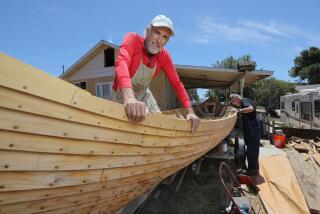Perseverance: Tool in His Shipbuilding Trade
Holland-born Cornelis van Dorp, 59, knew he would someday become a shipbuilder.
It just took him a long time to get his career in gear.
“My first ship was made from a wooden shoe and the sails were cut from old sheets,” said the retired La Habra man, a former medical technologist turned diesel mechanic teacher.
From there, he noted, most kids gravitate to a rowboat or a canoe, some made by hand.
But it wasn’t until he was in his early 30s that Van Dorp began serious shipbuilding, and through the years has only built six of them, all models and most replicas of early sailing ships.
“It takes a lot of time to build them from scratch,” he said. One of his boat models was built over a span of four years.
The others took nearly a year of painstaking work following plans of the original full-sized boats. All six have won awards.
“I’ve been around boats all my life,” said Van Dorp, whose father was a builder of full-size ships. “My family was in the merchant marine and some of my cousins built pleasure craft in Europe.”
Pleasure boating is a way of life in Holland, he said, because of the number of waterways in the country.
“That helped me appreciate the way a boat looks. There’s something about a boat and the lines they have,” he said. “You can see beauty in it and when it comes out of your own hands it feels good.”
His models, along with those of other builders, were recently exhibited at the Brea Civic and Cultural Gallery. They included table-top models, a miniature replica of the African Queen from the movie of the same name, a Venetian gondola, rigged sailing ships and a 100-pound sailing yacht.
Van Dorp’s entries included replicas of a 19th-Century Dutch inland freighter, a version of his former 40-foot cutter named Hendrike, a Dutch East Indian galleon, an 1850s schooner, a Maine lobster boat and a modern yacht.
Three of his boats are equipped with radio-controlled motors and are often sailed in a nearby pond, to the delight of neighborhood children and adults.
Building boats on any scale is a matter of perseverance, he says.
“A lot of people would like to build boats, but they don’t because they can’t persevere,” said Van Dorp, a member of the Fullerton Ship Modelers Assn. “But once you do it, it’s a real pleasure.”
His advice to new boat builders is “start simple and learn to persevere.”
He notes, however, there are few stores that cater to model boat builders. “It’s difficult to buy certain parts for model boats and stores that tried have folded up,” he said. “They can’t sell enough to make a living at it.”
Van Dorp said all his ships are technically accurate because he builds them from original plans, some of which he found in the Maritime Museum in Amsterdam.
But although he follows the plans, he often becomes innovative by using such items as pool cues for masts and portions of eye drop dispensers for life preservers.
Some boats are elaborately carved, which forced Van Dorp to learn that skill.
“A sculptor gave me a carving knife one day and told me to try it,” he said. “It’s difficult, but it sure looks good when you finish. Especially when you do it right.”
The competition at the ORCO Block Co. in Stanton was tense, but Jeff Voss, a Fontana mason, won the right to vie in Houston on Feb. 18 to decide who is the “Fastest Trowel on the Block.”
Voss won the Region V finals, competing against journeyman masons throughout the state who were judged in a 20-minute timed trial. They had to build a wall 24 feet long and were judged on workmanship and the number of blocks laid.
Rick Muth, president of ORCO, which co-sponsored the area event with National Concrete Masonry Assn., said the event is designed to help raise the visibility of concrete masonry as a profession.
More to Read
Sign up for The Wild
We’ll help you find the best places to hike, bike and run, as well as the perfect silent spots for meditation and yoga.
You may occasionally receive promotional content from the Los Angeles Times.





